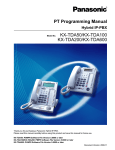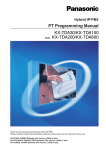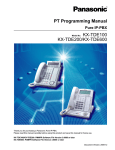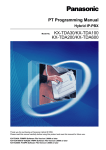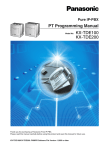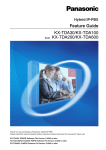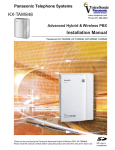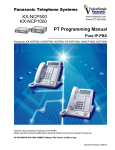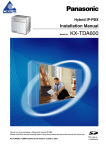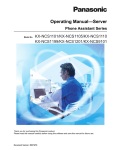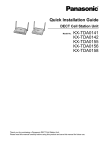Download PT Programming Manual
Transcript
Hybrid IP-PBX PT Programming Manual Model KX-TDA50/KX-TDA100 KX-TDA200/KX-TDA600 Thank you for purchasing a Panasonic Hybrid IP-PBX. Please read this manual carefully before using this product and save this manual for future use. KX-TDA50: PSMPR Software File Version 3.0000 or later KX-TDA100/KX-TDA200: PMPR Software File Version 3.0000 or later KX-TDA600: PLMPR Software File Version 3.0000 or later Document Version: 2006-02 Introduction About this Programming Manual The PT Programming Manual is designed to serve as a reference to programming the Panasonic Hybrid IP-PBX using a Panasonic proprietary telephone (PT) with display. The PT Programming Manual is divided into the following sections: Section 1, Overview Provides an overview of programming the PBX. Section 2, PT Programming Serves as reference operating instructions when using a display PT to program the PBX. Section 3, Appendix Provides a list of all related PT programming items for each feature as Feature Programming References. References Found in the PT Programming Manual PT Programming Manual References Related sections of the PT Programming Manual are listed for your reference. Feature Manual References The Feature Manual explains what the PBX can do, as well as how to obtain the most of its many features and facilities. Sections from the Feature Manual are listed throughout the PT Programming Manual for your reference. Installation Manual References The Installation Manual provides instructions detailing the installation and maintenance of the PBX. Sections from the Installation Manual are listed throughout the PT Programming Manual for your reference. Links to Other Pages and Manuals If you are viewing this manual with a PC, certain items are linked to different sections of the PT Programming Manual and other Hybrid IP-PBX manuals. Click on a link to jump to that section. Linked items include: • Installation Manual References • PT Programming Manual References • Feature Manual References WARNING Unplug the PBX from the AC outlet if it emits smoke, an abnormal smell or makes unusual noise. These conditions can cause fire or electric shock. Confirm that smoke has stopped and contact an authorized Panasonic Factory Service Centre. 2 PT Programming Manual NOTES • • • The contents of this manual apply to PBXs with a certain software version, as indicated on the cover of this manual. To confirm the software version of your PBX, see [190] Main Processing (MPR) Software Version Reference. Some optional service cards, PTs, and features are not available in some areas. Additionally, some optional service cards and features are not available for some PBX models. Please consult your certified Panasonic dealer for more information. Product specifications are subject to change without notice. PT Programming Manual 3 Table of Contents 1 Overview.................................................................................................. 7 1.1 1.1.1 1.1.2 1.1.3 2 Introduction ......................................................................................................................8 Introduction ........................................................................................................................8 Password Security..............................................................................................................8 Entering Characters ...........................................................................................................9 PT Programming................................................................................... 11 2.1 2.1.1 2.1.2 2.1.3 PT Programming ............................................................................................................12 Programming Instructions ................................................................................................12 Maximum Values ..............................................................................................................14 Basic Programming ..........................................................................................................16 [000] Date & Time............................................................................................................................................ 16 [001] System Speed Dialing Number .............................................................................................................. 17 [002] System Speed Dialing Name.................................................................................................................. 17 [003] Extension Number .................................................................................................................................. 17 [004] Extension Name ..................................................................................................................................... 17 [005] Extension Personal Identification Number (PIN) .................................................................................... 17 [006] Operator Assignment.............................................................................................................................. 18 [007] DSS Console Paired Telephone ............................................................................................................. 18 [008] Absent Message..................................................................................................................................... 18 2.1.4 System Management Programming.................................................................................18 [100] Flexible Numbering................................................................................................................................. 18 [101] Time Service Switching Mode ................................................................................................................ 19 [102] Time Service Starting Time .................................................................................................................... 19 [103] Idle Line Access (Local Access)............................................................................................................. 19 [110] System Password for Administrator—for PT Programming .................................................................... 19 [111] System Password for User—for PT Programming.................................................................................. 19 [112] Manager Password................................................................................................................................. 20 [120] Verification Code .................................................................................................................................... 20 [121] Verification Code Name.......................................................................................................................... 20 [122] Verification Code Personal Identification Number (PIN) ......................................................................... 20 [123] Verification Code COS Number.............................................................................................................. 20 [190] Main Processing (MPR) Software Version Reference ............................................................................ 21 2.1.5 Timer Programming .........................................................................................................21 [200] Hold Recall Time .................................................................................................................................... 21 [201] Transfer Recall Time............................................................................................................................... 21 [203] Intercept Time......................................................................................................................................... 21 [204] Hot Line Waiting Time ............................................................................................................................ 21 [205] Automatic Redial Repeat Times (KX-TDA100/KX-TDA200/KX-TDA600 only) ....................................... 21 [207] Door Open Duration ............................................................................................................................... 21 [208] Call Duration Count Starting Time for LCOT .......................................................................................... 22 [209] DISA Delayed Answer Time ................................................................................................................... 22 [210] DISA CO-to-CO Line Call Prolong Time................................................................................................. 22 [211] DISA Intercept Time ............................................................................................................................... 22 2.1.6 TRS/ARS Programming ...................................................................................................22 [300] TRS Override by System Speed Dialing ................................................................................................ 22 [301] TRS Denied Code .................................................................................................................................. 22 [302] TRS Exception Code .............................................................................................................................. 23 [303] Special Carrier Access Code ................................................................................................................. 23 [304] Emergency Number................................................................................................................................ 23 [320] ARS Mode .............................................................................................................................................. 23 [321] ARS Leading Number............................................................................................................................. 23 [322] ARS Routing Plan Table Number ........................................................................................................... 23 [325] ARS Exception Number.......................................................................................................................... 23 4 PT Programming Manual [330] ARS Routing Plan Time Table.................................................................................................................24 [331–346] ARS Routing Plan Table (1–16) (KX-TDA50/KX-TDA100/KX-TDA200 only) ..................................24 [347] ARS Routing Plan Table (1–48) (KX-TDA600 only) ................................................................................24 [350] ARS Carrier Name ..................................................................................................................................24 [351] ARS Trunk Group for Carrier Access ......................................................................................................24 [352] ARS Removed Number of Digits for Carrier Access ...............................................................................25 [353] ARS Carrier Access Code ......................................................................................................................25 2.1.7 CO Line Programming ..................................................................................................... 25 [400] LCOT CO Line Connection .....................................................................................................................25 [401] LCOT CO Line Name..............................................................................................................................25 [402] LCOT Trunk Group Number ....................................................................................................................25 [409] LCOT CO Line Number Reference .........................................................................................................26 [410] LCOT Dialing Mode.................................................................................................................................26 [411] LCOT Pulse Rate ....................................................................................................................................26 [412] LCOT DTMF Minimum Duration .............................................................................................................26 [413] LCOT CPC Signal Detection Time—Outgoing........................................................................................26 [414] LCOT CPC Signal Detection Time—Incoming........................................................................................26 [416] LCOT Pause Time...................................................................................................................................26 [417] LCOT Flash/Recall Time.........................................................................................................................27 [418] LCOT Disconnect Time...........................................................................................................................27 [450] DIL 1:1 Destination .................................................................................................................................27 [451] DID Number (KX-TDA100/KX-TDA200/KX-TDA600 only) ......................................................................27 [452] DID Name (KX-TDA100/KX-TDA200/KX-TDA600 only) .........................................................................27 [453] DID Destination (KX-TDA100/KX-TDA200/KX-TDA600 only).................................................................27 [470] Trunk Group Intercept Destination ..........................................................................................................28 [471] Host PBX Access Code ..........................................................................................................................28 [472] Extension-to-CO Line Call Duration ........................................................................................................28 [473] CO-to-CO Line Call Duration ..................................................................................................................28 [475] DISA Silence Detection...........................................................................................................................28 [476] DISA Continuous Signal Detection .........................................................................................................29 [477] DISA Cyclic Signal Detection..................................................................................................................29 [490] Caller ID Signal Type ..............................................................................................................................29 2.1.8 COS Programming........................................................................................................... 29 [500] Trunk Group Number ..............................................................................................................................29 [501] TRS Level ...............................................................................................................................................29 [502] CO Line Call Duration Limitation.............................................................................................................30 [503] Call Transfer to CO Line..........................................................................................................................30 [504] Call Forwarding to CO Line.....................................................................................................................30 [505] Executive Busy Override .........................................................................................................................30 [506] Executive Busy Override Deny................................................................................................................30 [507] DND Override .........................................................................................................................................30 [508] Account Code Mode ...............................................................................................................................30 [509] TRS Level for System Speed Dialing ......................................................................................................31 [510] TRS Level for Extension Dial Lock..........................................................................................................31 [511] Manager Assignment ..............................................................................................................................31 [512] Permission for Door Open Access ..........................................................................................................31 [514] Time Service Manual Switching..............................................................................................................31 [515] Wireless XDP Parallel Mode for Paired Telephone .................................................................................31 [516] Programming Mode Limitation ................................................................................................................31 2.1.9 Extension Programming................................................................................................... 32 [600] EXtra Device Port (XDP) Mode...............................................................................................................32 [601] Terminal Device Assignment...................................................................................................................32 [602] Class of Service ......................................................................................................................................32 [603] Extension User Group.............................................................................................................................32 [604] Extension Intercept Destination ..............................................................................................................32 [605] Call Forwarding—No Answer Time .........................................................................................................33 [606] CLIP Number ..........................................................................................................................................33 [620] Incoming Call Distribution Group Member ..............................................................................................33 [621] Incoming Call Distribution Group Delayed Ringing .................................................................................33 PT Programming Manual 5 [622] Incoming Call Distribution Group Floating Extension Number ............................................................... 33 [623] Incoming Call Distribution Group Name ................................................................................................. 33 [624] Incoming Call Distribution Group Distribution Method............................................................................ 34 [625] Destination for Overflow Time Expiration ............................................................................................... 34 [626] Overflow Time ........................................................................................................................................ 34 [627] Destination When All Busy ..................................................................................................................... 34 [628] Queuing Call Capacity............................................................................................................................ 34 [629] Queuing Hurry-up Level ......................................................................................................................... 35 [630] Queuing Time Table ............................................................................................................................... 35 [631] Sequences in Queuing Time Table......................................................................................................... 35 [632] Maximum Number of Agents .................................................................................................................. 35 [640] Extension User Groups of a Paging Group ............................................................................................ 35 [641] External Pagers of a Paging Group ........................................................................................................ 36 [650] Extension User Groups of a Pickup Group............................................................................................. 36 [660] VM Group Floating Extension Number................................................................................................... 36 [680] Idle Extension Hunting Type ................................................................................................................... 36 [681] Idle Extension Hunting Group Member .................................................................................................. 37 [690] PS Registration....................................................................................................................................... 37 [691] PS Termination ....................................................................................................................................... 37 [692] Personal Identification Number (PIN) for PS Registration ...................................................................... 38 [699] CS Status Reference.............................................................................................................................. 38 2.1.10 Resource/Interface Programming ....................................................................................38 [700] External Pager Floating Extension Number ........................................................................................... 38 [710] Music Source Selection for BGM (with the KX-TDA50)/BGM2 (with the KX-TDA100/KX-TDA200/KXTDA600) .......................................................................................................................................................... 38 [711] Music on Hold......................................................................................................................................... 38 [712] Music for Transfer ................................................................................................................................... 39 [720] Doorphone Call Destination ................................................................................................................... 39 [729] Doorphone Number Reference .............................................................................................................. 39 [730] Outgoing Message (OGM) Floating Extension Number ......................................................................... 39 [731] Outgoing Message (OGM) Name........................................................................................................... 40 [732] DISA Security Mode ............................................................................................................................... 40 2.1.11 SMDR & Maintenance Programming ...............................................................................40 [800] RS-232C Parameter—New Line Code ................................................................................................... 40 [800] RS-232C Parameter—Baud Rate........................................................................................................... 40 [800] RS-232C Parameter—Word Length ....................................................................................................... 40 [800] RS-232C Parameter—Parity Bit ............................................................................................................. 40 [800] RS-232C Parameter—Stop Bit Length ................................................................................................... 40 [801] External Modem Control......................................................................................................................... 41 [802] SMDR Page Length................................................................................................................................ 41 [803] SMDR Skip Perforation........................................................................................................................... 41 [804] SMDR Outgoing Call Printing ................................................................................................................. 41 [805] SMDR Incoming Call Printing ................................................................................................................. 41 [810] Remote Programming ............................................................................................................................ 41 [811] Modem Floating Extension Number ....................................................................................................... 41 [812] ISDN Remote Floating Extension Number (KX-TDA100/KX-TDA200/KX-TDA600 only)....................... 42 2.1.12 Card Programming ...........................................................................................................42 [900] Slot Card Type Reference ...................................................................................................................... 42 [901] Slot Card Deletion .................................................................................................................................. 42 [902] Slot Card Reset ...................................................................................................................................... 42 [910] OPB3 Option Card Type Reference (KX-TDA100/KX-TDA200/KX-TDA600 only) ................................. 42 [911] OPB3 Option Card Deletion (KX-TDA100/KX-TDA200/KX-TDA600 only) ............................................. 43 3 3.1 6 Appendix ............................................................................................... 45 Feature Programming References ...............................................................................46 PT Programming Manual Section 1 Overview This section provides an overview of programming the PBX. PT Programming Manual 7 1.1 Introduction 1.1 Introduction 1.1.1 Introduction These programming instructions are designed to serve as an overall system programming reference for the Panasonic Hybrid IP-PBX. Each feature in the PBX has default settings that can be changed to customise the PBX to your requirements. These settings control the functions of the PBX, and changing them is referred to as "system programming". Only one person can perform system programming at a time. Any other users trying to enter system programming mode will be denied access. Ways to Program There are two programming methods: • PC (Personal Computer) Programming All features and settings of the PBX can be programmed through PC programming with KXTDA Maintenance Console. Installing and starting Maintenance Console are explained in the Installation Manual. • PT (Proprietary Telephone) Programming A subset of the features and settings of the PBX can be programmed using a PT. PT programming is described in Section 2.1 PT Programming. An extension user can perform system programming by entering three-digit programming numbers with a PT. 1.1.2 Password Security To maintain system security, system passwords are required to access certain programming functions of the PBX. By giving different users access to different passwords, it is possible to control the amount of programming that each user is able to perform. The following types of system passwords are available: Password Description Format System Password (PT) for User Used to access user-level PT programming. The specific PT programming items that may be programmed at user level can be selected through system programming. 4 – 10 digits System Password (PT) for Administrator Used to access administrator-level PT programming. All PT programming settings are available. Warning to the Administrator or Installer regarding the system password 1. Please provide all system passwords to the customer. 2. To avoid unauthorized access and possible abuse of the PBX, keep the passwords secret, and inform the customer of the importance of the passwords, and the possible dangers if they become known to others. 3. The PBX has default passwords preset. For security, change these passwords the first time that you program the PBX. 4. Change the passwords periodically. 8 PT Programming Manual 1.1 Introduction 5. It is strongly recommended that passwords of 10 numbers or characters be used for maximum protection against unauthorized access. For a list of numbers and characters that can be used in system passwords, refer to Section 1.1.3 Entering Characters. 6. If a system password is forgotten, it can be found by loading a backup of the system data into a PC, and checking the password using the KX-TDA Maintenance Console software. If you do not have a backup of the system data, you must reset the PBX to its factory defaults and reprogram it. Therefore, we strongly recommend maintaining a backup of the system data. For more information on how to back up the system data, refer to the on-line help of the Maintenance Console. However, as system passwords can be extracted from backup copies of the system data file, do not allow unauthorized access to these files. 1.1.3 Entering Characters The following characters can be used when storing a name, message, or other text entry data using a PT. The tables below show you the characters available by pushing each button a specific number of times. Table 1 (Standard mode) PT Programming Manual 9 1.1 Introduction Table 2 (Option mode) [Example of Entering Characters] To enter "Ann": n A 2 6 n (5 times) 6 OR (5 times) FWD/DND Notes • • To move the cursor to the left, press • To move the cursor to the right, press . When entering two or more characters that use the same button consecutively (e.g. "G" and "I"), you must press this button or the FWD/DND button after entering the first character. If SELECT is pressed, the characters for each button will be displayed in reverse order. To toggle between Table 1 and Table 2 when using KX-T7600 series, press the leftmost soft button. • • 10 To erase the character on the cursor, press CLEAR. PT Programming Manual . Section 2 PT Programming This section serves as reference operating instructions when using a display PT to program the PBX. PT Programming Manual 11 2.1 PT Programming 2.1 PT Programming 2.1.1 Programming Instructions Required Telephone/Extension PBX settings can be customised through system programming by using a proprietary telephone (PT) with a multiline display, such as the KX-T7636. To access system programming, the Class of Service (COS) assigned to the PT's extension must be programmed to allow system programming, or the PT must be connected to the lowest-numbered port on the card installed in the lowest-numbered slot. Only one system programming session can be performed at a time. This means that only one user can access system programming at a time, whether through a PT or PC. For a list of characters that can be entered during system programming, see Section 1.1.3 Entering Characters. Buttons and Functions Fixed Buttons Function T7600/IP-PT*1 T7200/T7400*2 REDIAL SP-PHONE FWD/DND PREVIOUS NEXT (Page up) CONF (Page down) AUTO DIAL ENTER STORE Back to Previous Menu (CANCEL) — SHIFT SHIFT SHIFT PAUSE PROGRAM HOLD 12 PT Programming Manual HOLD PAUSE PROGRAM END 2.1 PT Programming Fixed Buttons T7600/IP-PT*1 AUTO ANS Function T7200/T7400*2 MESSAGE AUTO ANSWER SELECT MESSAGE MUTE MUTE FLASH/ RECALL FLASH FLASH TRANSFER CLEAR TRANSFER INTERCOM SECRET INTERCOM *1: The buttons shown in this column are from the KX-T7600 series. *2: The buttons shown in this column are from the KX-T7400 series. Entering System Programming Mode Using a PT to perform system programming allows an authorized extension user to set a wide range of PBX features and parameters. There are two levels of system programming that can be performed with a PT: administrator-level programming and user-level programming. Administrator Level: Allows the programming of all settings accessible through PT programming. System Password for Administrator # —for PT Programming PROGRAM/ PAUSE Programming No. 3 digits = 1234 User Level: Allows the programming of limited settings as permitted through PC programming. System Password for User —for PT Programming PROGRAM/ PAUSE Programming No. 3 digits = 1234 Note means default value throughout this manual. Programming Structure Programming Number Programming Group Title [0XX] Basic Programming Description Frequently used programming steps PT Programming Manual 13 2.1 PT Programming Programming Number Programming Group Title [1XX] System Management Programming [2XX] Timer Programming Global system parameters System timers TRS/ARS Programming [3XX] TRS and Automatic Route Selection (ARS) programming [4XX] CO Line Programming [5XX] COS Programming [6XX] Extension Programming [7XX] Resource/Interface Programming PBX interface and external device settings SMDR & Maintenance Programming Station Message Detail Recording (SMDR) and maintenance feature settings [8XX] CO line and trunk group settings Class of Service parameters Card Programming Extension feature settings Used to display the cards currently installed in the PBX, or to "delete" a card from system programming before physically removing it. [9XX] 2.1.2 Description Maximum Values Throughout this manual, maximum entry values are shown for each programming item. When maximum entry values for one or more of the supported PBX models differ, these differences are listed within the programming item, as shown in the example below. [351] ENTER Carrier Table No. Trunk Group No. KX-TDA50: 01–10 KX-TDA100: 01–10 KX-TDA200: 01–10 KX-TDA600: 01–48 KX-TDA50: 01–64 KX-TDA100: 01–64 KX-TDA200: 01–64 KX-TDA600: 01–96 SELECT Disable/ Enable ENTER END These values vary by PBX model However, please note that extension number, slot and port entry values are not listed within each programming item. These values vary depending on the model of PBX and the card type installed, as shown below. Extension Numbers (Including Feature Numbers) • • 14 KX-TDA50/KX-TDA100/KX-TDA200: 1–4 digits KX-TDA600: 1–5 digits PT Programming Manual 2.1 PT Programming KX-TDA50 Slot and Port Values Available Slot Entry Values Slot Number Supported Cards 01 Pre-installed Super Hybrid Ports 02–04 DLC4, HLC4, PLC4, LCOT4 cards 05–07 DLC8, PLC8, SLC8 cards 08–09 DPH4 cards Enter slot numbers as two-digit numbers (e.g. "04" for slot 4). Available Port Entry Values Card Type Port Number Related Programming DLC4 01–04 HLC4 01–04 PLC4 01–04 DLC8 01–08 PLC8 01–08 DPH4 01–04 [72x] LCOT4 01–04 [40x] [41x] [450] Pre-installed Super Hybrid Ports 01–04 [600] [601] [600] [601] Enter port numbers as two-digit numbers (e.g. "04" for port 4). KX-TDA100/KX-TDA200/KX-TDA600 Slot and Port Values Available Slot Entry Values KX-TDA100/KX-TDA200 PBX Model Slot Number KX-TDA100 01–06 KX-TDA200 01–11 Supported Cards All cards Enter slot numbers as two-digit numbers (e.g. "04" for slot 4). KX-TDA600 PT Programming Manual 15 2.1 PT Programming Slot Number Supported Cards 101–110 201–211 301–311 401–411 All cards Enter slot numbers as three-digit numbers of the form "XYY": • X: Shelf number (1-4) • YY: Slot number (01-11) Available Port Entry Values Card Type Port Number Related Programming DHLC8 01–08 DLC8 01–08 DLC16 01–16 DPH4 01–04 [72x] LCOT8 (KX-TDA100/KXTDA200 only) 01–08 [40x] [41x] [450] LCOT16 (KX-TDA100/KXTDA200 only) 01–16 ELCOT16 (KX-TDA600 only) 01–16 [600] [601] Enter port numbers as two-digit numbers (e.g. "04" for port 4). 2.1.3 Basic Programming [000] Date & Time [000] ENTER NEXT 16 PT Programming Manual Year Month Date 00–99 01–12 01–31 Hour Minute 01–12 00–59 SELECT (AUTO ANS/MESSAGE) AM/PM ENTER ENTER END (HOLD) 2.1 PT Programming [001] System Speed Dialing Number [001] Speed Dialing No. Telephone No. 000–999 Max. 32 digits ENTER END ENTER To the Next Speed Dialing No. To the Desired Speed Dialing No. NEXT CANCEL [002] System Speed Dialing Name [002] ENTER Speed Dialing No. Name 000–999 Max. 20 characters END ENTER [003] Extension Number [003] Current Extn. No. New Extn. No. END 101– ENTER Notes • • • ENTER Extensions that will have a mailbox using a VM in DPT integration must have extension numbers of 2–4 digits. Extension numbers of PSs can be a maximum of 4 digits. If PC Phone, PC Console, or a CTI application is running on a PC connected to an extension whose extension number is to be programmed/modified, quit the application first. [004] Extension Name [004] Extn. No. Name Max. 20 characters ENTER END ENTER [005] Extension Personal Identification Number (PIN) [005] Extn. No. ENTER PIN Max. 10 digits ENTER END WARNING There is a risk that fraudulent telephone calls will be made if a third party discovers a personal identification number (PIN) (verification code PIN or extension PIN) of the PBX. PT Programming Manual 17 2.1 PT Programming The cost of such calls will be billed to the owner/renter of the PBX. To protect the PBX from this kind of fraudulent use, we strongly recommend: a) Keeping PINs secret. b) Selecting complex, random PINs that cannot be easily guessed. c) Changing PINs frequently. [006] Operator Assignment [006] Extn. No. Time No. ENTER 1 Day/2 Lunch/ 3 Break/4 Night END 101– ENTER [007] DSS Console Paired Telephone [007] DSS Console No. Extn. No. KX-TDA50: 01–04 KX-TDA100: 01–08 KX-TDA200: 01–08 KX-TDA600: 01–64 ENTER ENTER END Note This program is only available after the port connected to the DSS Console is assigned as "DSS Console" in [601] Terminal Device Assignment. [008] Absent Message [008] ENTER Location No. Message 1–8 Max. 16 characters END ENTER For default values, see "1.1.1 Absent Message" in the Feature Manual. 2.1.4 System Management Programming [100] Flexible Numbering [100] Location No. Feature No. 01–68 ENTER ENTER END (HOLD) To the Next Location No. To the Desired Location No. NEXT CANCEL For default values, see "1.6.4 Flexible Numbering/Fixed Numbering" in the Feature Manual. 18 PT Programming Manual 2.1 PT Programming [101] Time Service Switching Mode [101] ENTER SELECT (AUTO ANS/MESSAGE) Manual/Automatic END ENTER [102] Time Service Starting Time [102] Day No. Time No. 0 Sun/1 Mon/ 2 Tue/3 Wed/ 4 Thu/5 Fri/6 Sat ENTER Hour:Minute 01:00–12:59 1 Day-1/2 Lunch/ 3 Day-2/4 Night SELECT AM/PM END ENTER To the Next Time No. To the Next Day No. NEXT Page up [103] Idle Line Access (Local Access) [103] Location No. ENTER KX-TDA50: 01–64 KX-TDA100: 01–64 KX-TDA200: 01–64 KX-TDA600: 01–96 Trunk Group No. KX-TDA50: 01–64 KX-TDA100: 01–64 KX-TDA200: 01–64 KX-TDA600: 01–96 Location No.=Trunk Group No. END ENTER [110] System Password for Administrator—for PT Programming [110] Password ENTER 4–10 digits 1234 END ENTER [111] System Password for User—for PT Programming [111] Password ENTER 4–10 digits 1234 END ENTER PT Programming Manual 19 2.1 PT Programming [112] Manager Password [112] Password ENTER 4–10 digits 1234 END ENTER [120] Verification Code [120] ENTER Location No. Verification Code 0001–1000 1–4 digits END ENTER [121] Verification Code Name [121] ENTER Location No. Name 0001–1000 Max. 20 characters END ENTER [122] Verification Code Personal Identification Number (PIN) [122] ENTER Location No. PIN 0001–1000 Max. 10 digits END ENTER WARNING There is a risk that fraudulent telephone calls will be made if a third party discovers a personal identification number (PIN) (verification code PIN or extension PIN) of the PBX. The cost of such calls will be billed to the owner/renter of the PBX. To protect the PBX from this kind of fraudulent use, we strongly recommend: a) Keeping PINs secret. b) Selecting complex, random PINs that cannot be easily guessed. c) Changing PINs frequently. [123] Verification Code COS Number [123] ENTER 20 PT Programming Manual Location No. COS No. 0001–1000 01–64 01 END ENTER 2.1 PT Programming [190] Main Processing (MPR) Software Version Reference [190] MPR Version 2.1.5 END Reference only ENTER Timer Programming [200] Hold Recall Time [200] Time ENTER 0–240 s 60 s END (HOLD) ENTER [201] Transfer Recall Time [201] Time ENTER END 1–240 s 60 s ENTER [203] Intercept Time [203] ENTER Time No. Time 1 Day/2 Lunch 3 Break/4 Night 1–240 s 40 s END ENTER [204] Hot Line Waiting Time [204] Time ENTER END 0–15 s 1s ENTER [205] Automatic Redial Repeat Times (KX-TDA100/KX-TDA200/KXTDA600 only) [205] Number of Times END 0–10 0 ENTER ENTER [207] Door Open Duration [207] Time ENTER 2–7 s 5s END ENTER PT Programming Manual 21 2.1 PT Programming [208] Call Duration Count Starting Time for LCOT [208] Time END 0–60 s 0s ENTER ENTER [209] DISA Delayed Answer Time [209] Time END 0–30 s 5s ENTER ENTER [210] DISA CO-to-CO Line Call Prolong Time [210] Time END 0–7 min 3 min ENTER ENTER [211] DISA Intercept Time [211] ENTER 2.1.6 Time No. Time 1 Day/2 Lunch 3 Break/4 Night 0–60 s 40 s END ENTER TRS/ARS Programming [300] TRS Override by System Speed Dialing [300] ENTER SELECT (AUTO ANS/MESSAGE) Disable/ Enable ENTER END (HOLD) [301] TRS Denied Code [301] ENTER Level No. Location No. Denied Code 2–6 001–100 Max. 16 digits To the Next Location No. To the Desired Location No. NEXT CANCEL 22 PT Programming Manual END ENTER 2.1 PT Programming [302] TRS Exception Code [302] Level No. ENTER Exception Code Location No. 2–6 001–100 END Max. 16 digits ENTER [303] Special Carrier Access Code [303] Location No. ENTER Carrier Access Code KX-TDA50: 01–20 KX-TDA100: 01–20 KX-TDA200: 01–20 KX-TDA600: 001–100 Max. 16 digits END ENTER [304] Emergency Number [304] ENTER Location No. Emergency No. 01–10 Max. 32 digits ENTER END [320] ARS Mode [320] ENTER SELECT Off/Idle Line/ All Access END ENTER [321] ARS Leading Number [321] ENTER Location No. Leading No. 0001–1000 Max. 16 digits END ENTER [322] ARS Routing Plan Table Number [322] ENTER Location No. Plan Table No. 0001–1000 KX-TDA50: 01–16 KX-TDA100: 01–16 KX-TDA200: 01–16 KX-TDA600: 01–48 01 END ENTER [325] ARS Exception Number [325] Location No. ENTER 001–200 Exception No. Max. 16 digits ENTER END PT Programming Manual 23 2.1 PT Programming [330] ARS Routing Plan Time Table [330] Plan Table No. KX-TDA50: 01–16 KX-TDA100: 01–16 KX-TDA200: 01–16 KX-TDA600: 01–48 ENTER Hour:Minute 0 Sun/1 Mon/2 Tue/ 3 Wed/4 Thu/5 Fri/6 Sat SELECT AM/PM 01–12/00–59 ARS Time No. Day No. 1 TimeA/2 TimeB/ 3 TimeC/4 TimeD END ENTER [331–346] ARS Routing Plan Table (1–16) (KX-TDA50/KX-TDA100/KXTDA200 only) [331–346] Day No. 0 Sun/1 Mon/2 Tue/ 3 Wed/4 Thu/5 Fri/6 Sat ENTER ARS Time No. Priority 1 TimeA/2 TimeB/ 3 TimeC/4 TimeD 1–6 Carrier Table No. KX-TDA50: 1–10/ None KX-TDA100: 1–10/ None KX-TDA200: 1–10/ None END ENTER [347] ARS Routing Plan Table (1–48) (KX-TDA600 only) [347] Plan Table No. ARS Time No. Priority 01–48 1 TimeA/2 TimeB/ 3 TimeC/4 TimeD 1–6 ENTER Carrier Table No. 1–48/ END None ENTER [350] ARS Carrier Name [350] ENTER Carrier Table No. Name KX-TDA50: 01–10 KX-TDA100: 01–10 KX-TDA200: 01–10 KX-TDA600: 01–48 Max. 20 characters ENTER END [351] ARS Trunk Group for Carrier Access [351] ENTER 24 PT Programming Manual Carrier Table No. Trunk Group No. KX-TDA50: 01–10 KX-TDA100: 01–10 KX-TDA200: 01–10 KX-TDA600: 01–48 KX-TDA50: 01–64 KX-TDA100: 01–64 KX-TDA200: 01–64 KX-TDA600: 01–96 SELECT Disable/ Enable ENTER END 2.1 PT Programming [352] ARS Removed Number of Digits for Carrier Access [352] ENTER Carrier Table No. Digits to Remove KX-TDA50: 01–10 KX-TDA100: 01–10 KX-TDA200: 01–10 KX-TDA600: 01–48 0–15 0 END ENTER [353] ARS Carrier Access Code [353] ENTER 2.1.7 Carrier Table No. Carrier Access Code KX-TDA50: 01–10 KX-TDA100: 01–10 KX-TDA200: 01–10 KX-TDA600: 01–48 Max. 32 digits END ENTER CO Line Programming [400] LCOT CO Line Connection [400] Slot No. Port No. ENTER SELECT (AUTO ANS/MESSAGE) No Connect/ Connect To the Desired Port No. END (HOLD) ENTER To the Next Port No. CANCEL NEXT [401] LCOT CO Line Name [401] ENTER CO Line No. Name 3 digits Max. 20 characters END ENTER [402] LCOT Trunk Group Number [402] ENTER CO Line No. Trunk Group No. 3 digits KX-TDA50: 01–64 KX-TDA100: 01–64 KX-TDA200: 01–64 KX-TDA600: 01–96 01 END ENTER PT Programming Manual 25 2.1 PT Programming [409] LCOT CO Line Number Reference [409] Slot No. Port No. CO Line No. END Reference only ENTER [410] LCOT Dialing Mode [410] Slot No. Port No. ENTER SELECT DTMF/Pulse END ENTER [411] LCOT Pulse Rate [411] Slot No. Port No. SELECT Low/High END ENTER ENTER [412] LCOT DTMF Minimum Duration [412] Slot No. Port No. ENTER SELECT 80/160 ms END ENTER [413] LCOT CPC Signal Detection Time—Outgoing [413] Slot No. Port No. Mode No. 0: None/1: 6.5/ 2–113: (N–1)×8 ms 051 (400 ms) ENTER END ENTER [414] LCOT CPC Signal Detection Time—Incoming [414] Slot No. Port No. Mode No. 0: None/1: 6.5/ 2–113: (N–1)×8 ms 051 (400 ms) ENTER END ENTER [416] LCOT Pause Time [416] Slot No. ENTER 26 PT Programming Manual Port No. SELECT 1.5/2.5/ 3.5/4.5 s END ENTER 2.1 PT Programming [417] LCOT Flash/Recall Time [417] Slot No. Port No. ENTER SELECT None/80/96/112/ 300/ 600/900/ 1200 ms/option END ENTER [418] LCOT Disconnect Time [418] Slot No. Port No. SELECT 0.5/ 1.5/2.0/ 4.0/12.0 s ENTER END ENTER [450] DIL 1:1 Destination [450] Slot No. Time No. ENTER Port No. Destination No. 1 Day/2 Lunch/ 3 Break/4 Night 1–5 digits END ENTER [451] DID Number (KX-TDA100/KX-TDA200/KX-TDA600 only) [451] ENTER Location No. DID No. 0001–1000 Max. 32 digits ENTER END [452] DID Name (KX-TDA100/KX-TDA200/KX-TDA600 only) [452] ENTER Location No. Name 0001–1000 Max. 20 characters END ENTER [453] DID Destination (KX-TDA100/KX-TDA200/KX-TDA600 only) [453] ENTER Time No. Location No. Destination No. 1 Day/2 Lunch/ 3 Break/4 Night 0001–1000 1–5 digits END ENTER PT Programming Manual 27 2.1 PT Programming [470] Trunk Group Intercept Destination [470] ENTER Time No. Trunk Group No. Destination No. 1 Day/2 Lunch/ 3 Break/4 Night KX-TDA50: 01–64 KX-TDA100: 01–64 KX-TDA200: 01–64 KX-TDA600: 01–96 Max. 32 digits END ENTER [471] Host PBX Access Code [471] Trunk Group No. Location No. KX-TDA50: 01–64 KX-TDA100: 01–64 KX-TDA200: 01–64 KX-TDA600: 01–96 01–10 ENTER Host PBX Access Code END Max.10 digits ENTER [472] Extension-to-CO Line Call Duration [472] Trunk Group No. ENTER KX-TDA50: 01–64 KX-TDA100: 01–64 KX-TDA200: 01–64 KX-TDA600: 01–96 Time 01–60 min 10 min END ENTER [473] CO-to-CO Line Call Duration [473] ENTER Trunk Group No. Time KX-TDA50: 01–64 KX-TDA100: 01–64 KX-TDA200: 01–64 KX-TDA600: 01–96 01–60 min 10 min END ENTER [475] DISA Silence Detection [475] Trunk Group No. ENTER 28 PT Programming Manual KX-TDA50: 01–64 KX-TDA100: 01–64 KX-TDA200: 01–64 KX-TDA600: 01–96 SELECT No Detect/ Detect ENTER END 2.1 PT Programming [476] DISA Continuous Signal Detection [476] Trunk Group No. SELECT No Detect/ Detect KX-TDA50: 01–64 KX-TDA100: 01–64 KX-TDA200: 01–64 KX-TDA600: 01–96 ENTER END ENTER [477] DISA Cyclic Signal Detection [477] Trunk Group No. SELECT No Detect/ Detect KX-TDA50: 01–64 KX-TDA100: 01–64 KX-TDA200: 01–64 KX-TDA600: 01–96 ENTER END ENTER [490] Caller ID Signal Type [490] Slot No. SELECT FSK/FSK with Visual Caller ID/DTMF ENTER ENTER 2.1.8 END COS Programming [500] Trunk Group Number [500] ENTER Time No. COS No. 1 Day/2 Lunch/ 3 Break/4 Night 01–64 Trunk Group No. KX-TDA50: 01–64 KX-TDA100: 01–64 KX-TDA200: 01–64 KX-TDA600: 01–96 SELECT (AUTO ANS/MESSAGE) Disable/ Enable ENTER END (HOLD) To the Next To the Next Trunk Group COS No. No. NEXT Page up [501] TRS Level [501] Time No. ENTER 1 Day/2 Lunch/ 3 Break/4 Night COS No. 01–64 Level 1–7 1 ENTER END PT Programming Manual 29 2.1 PT Programming [502] CO Line Call Duration Limitation [502] COS No. ENTER 01–64 SELECT Disable/ Enable ENTER SELECT Disable/ Enable ENTER SELECT Disable/ Enable ENTER SELECT Disable/ Enable ENTER END [503] Call Transfer to CO Line [503] COS No. ENTER 01–64 END [504] Call Forwarding to CO Line [504] COS No. ENTER 01–64 END [505] Executive Busy Override [505] COS No. ENTER 01–64 END [506] Executive Busy Override Deny [506] COS No. ENTER 01–64 SELECT Disable/ Enable ENTER SELECT Disable/ Enable ENTER SELECT Option/ Forced ENTER END [507] DND Override [507] COS No. ENTER 01–64 END [508] Account Code Mode [508] COS No. ENTER 30 PT Programming Manual 01–64 END 2.1 PT Programming [509] TRS Level for System Speed Dialing [509] ENTER COS No. TRS Level 01–64 1–7 1 END ENTER [510] TRS Level for Extension Dial Lock [510] ENTER COS No. TRS Level 01–64 1–7 7 END ENTER [511] Manager Assignment [511] COS No. ENTER 01–64 SELECT Disable/Enable * Only COS No. 64 is set to Enable. END ENTER [512] Permission for Door Open Access [512] COS No. ENTER 01–64 SELECT Disable/ Enable END ENTER [514] Time Service Manual Switching [514] COS No. ENTER 01–64 SELECT Disable/ Enable END ENTER [515] Wireless XDP Parallel Mode for Paired Telephone [515] COS No. ENTER 01–64 SELECT Disable/ Enable END ENTER [516] Programming Mode Limitation [516] COS No. ENTER 01–64 SELECT Disable/ Personal/ System&Personal END ENTER PT Programming Manual 31 2.1 PT Programming 2.1.9 Extension Programming [600] EXtra Device Port (XDP) Mode [600] Slot No. Port No. ENTER SELECT (AUTO ANS/MESSAGE) Off/On ENTER END (HOLD) To the Next Port No. To the Desired Port No. NEXT CANCEL [601] Terminal Device Assignment [601] Slot No. Port No. SELECT END See below ENTER KX-TDA50: Telephone/ DSS Console 01–04/ Voice Mail 1–(01–04)/ PC Console 1–2 KX-TDA100/KX-TDA200: Telephone/ DSS Console 01–08/ Voice Mail 1–(01–12)/ Voice Mail 2–(01–12)/ PC Console 1–8 ENTER KX-TDA600: Telephone/ DSS Console 01–64/ Voice Mail (1–8)–(01–12)/ PC Console 1–8 [602] Class of Service [602] Extn. No. COS No. 01–64 01 ENTER ENTER END [603] Extension User Group [603] Extn. No. Extn. User Group No. KX-TDA50: 001–032 KX-TDA100: 001–032 KX-TDA200: 001–032 KX-TDA600: 001–096 001 ENTER ENTER END [604] Extension Intercept Destination [604] Time No. ENTER 32 PT Programming Manual 1 Day/2 Lunch/ 3 Break/4 Night Extn. No. Destination No. Max. 32 digits ENTER END 2.1 PT Programming [605] Call Forwarding—No Answer Time [605] Extn. No. Time 0–120 s 15 s ENTER END ENTER [606] CLIP Number [606] Extn. No. CLIP No. Max. 16 digits ENTER END ENTER [620] Incoming Call Distribution Group Member Incoming Call Distribution Group No. [620] ENTER 001–128 ENTER Location No. Extn. No. KX-TDA50: 01–32 KX-TDA100: 01–32 KX-TDA200: 01–32 KX-TDA600: 001–128 END [621] Incoming Call Distribution Group Delayed Ringing Incoming Call Distribution Group No. [621] ENTER 001–128 Location No. KX-TDA50: 01–32 KX-TDA100: 01–32 KX-TDA200: 01–32 KX-TDA600: 001–128 SELECT Immediate/ 1–6 (rings)/ No ring END ENTER [622] Incoming Call Distribution Group Floating Extension Number [622] ENTER Incoming Call Distribution Group No. Extn. No. END ENTER 001–128 [623] Incoming Call Distribution Group Name [623] ENTER Incoming Call Distribution Group No. Name Max. 20 characters ENTER END 001–128 PT Programming Manual 33 2.1 PT Programming [624] Incoming Call Distribution Group Distribution Method Incoming Call Distribution Group No. [624] ENTER SELECT Ring/UCD/ Priority Hunt END ENTER 001–128 [625] Destination for Overflow Time Expiration Incoming Call Distribution Group No. [625] ENTER Time No. Destination No. 1 Day/2 Lunch/ 3 Break/4 Night Max. 32 digits 001–128 END ENTER [626] Overflow Time Incoming Call Distribution Group No. [626] ENTER Overflow Time ( None/1–125)×10 s END ENTER 001–128 [627] Destination When All Busy Incoming Call Distribution Group No. [627] ENTER Time No. Destination No. 1 Day/2 Lunch/ 3 Break/4 Night Max. 32 digits 001–128 END ENTER [628] Queuing Call Capacity [628] ENTER Incoming Call Distribution Group No. 001–128 34 PT Programming Manual Number in Queuing 0–30 30 ENTER END 2.1 PT Programming [629] Queuing Hurry-up Level Incoming Call Distribution Group No. [629] ENTER Hurry-up Level None/1–30 ENTER END 001–128 [630] Queuing Time Table Incoming Call Distribution Group No. [630] ENTER Time No. Table No. 1 Day/2 Lunch/ KX-TDA50: None/01–64 3 Break/4 Night KX-TDA100: None/01–64 KX-TDA200: None/01–64 KX-TDA600: None/001–128 001–128 END ENTER [631] Sequences in Queuing Time Table [631] Table No. ENTER Location No. KX-TDA50: 01–64 KX-TDA100: 01–64 KX-TDA200: 01–64 KX-TDA600: 001–128 SELECT None/Overflow/ Disconnect/"N" × 5 s/ Sequence "N"/OGM "N" 01–16 * A number must be entered in place of the "N". END ENTER [632] Maximum Number of Agents [632] ENTER Incoming Call Distribution Group No. Number of Agents No Limitation/01–32 ENTER END 001–128 [640] Extension User Groups of a Paging Group [640] ENTER Paging Group No. Extn. User Group No. KX-TDA50: 01–32 KX-TDA100: 01–32 KX-TDA200: 01–32 KX-TDA600: 01–96 KX-TDA50: 001–032 KX-TDA100: 001–032 KX-TDA200: 001–032 KX-TDA600: 001–096 SELECT END No/Yes ENTER KX-TDA50/KX-TDA100/KX-TDA200: Paging Group No. 01–31=Extn. User Group No. 001–031, Paging Group No. 32=All extension user groups KX-TDA600: Paging Group No.= Extn. User Group No. PT Programming Manual 35 2.1 PT Programming [641] External Pagers of a Paging Group [641] Paging Group No. External Pager No. KX-TDA50: 01–32 KX-TDA100: 01–32 KX-TDA200: 01–32 KX-TDA600: 01–96 ENTER KX-TDA50: 1 KX-TDA100: 1–2 KX-TDA200: 1–2 KX-TDA600: 1–2 SELECT No/ Yes END ENTER [650] Extension User Groups of a Pickup Group [650] ENTER Pickup Group No. Extn. User Group No. KX-TDA50: 01–64 KX-TDA100: 01–64 KX-TDA200: 01–64 KX-TDA600: 01–96 KX-TDA50: 001–032 KX-TDA100: 001–032 KX-TDA200: 001–032 KX-TDA600: 001–096 SELECT END No/Yes ENTER KX-TDA50/100/200: Pickup Group No. 01–32=Extn. User Group No. 001–032, Pickup Group No. 33–64=All extension user groups KX-TDA600: Pickup Group No.=Extn. User Group No. [660] VM Group Floating Extension Number [660] ENTER VM (DPT) Group No. Extn. No. KX-TDA50: 1 KX-TDA100: 1–2 KX-TDA200: 1–2 KX-TDA600: 1–8 KX-TDA50: 500 KX-TDA100: Group 1=500 KX-TDA200: Group 1=500 KX-TDA600: Group 1=500 ENTER END [680] Idle Extension Hunting Type [680] Hunting Group No. ENTER 36 PT Programming Manual KX-TDA50: 01–64 KX-TDA100: 01–64 KX-TDA200: 01–64 KX-TDA600: 001–128 SELECT Circular/ Terminate END ENTER 2.1 PT Programming [681] Idle Extension Hunting Group Member [681] Hunting Group No. ENTER Location No. 01–16 KX-TDA50: 01–64 KX-TDA100: 01–64 KX-TDA200: 01–64 KX-TDA600: 001–128 Extn. No. END ENTER [690] PS Registration [690] PS No. ENTER Extn. No. See below ENTER To the PS operation below END KX-TD7690 KX-TDA50: 001–028 KX-TDA100: 001–128 KX-TDA200: 001–128 KX-TDA600 (without EMEC): 001–256 KX-TDA600 (with EMEC): 001–512 Notes • • Push power button for 2 seconds. Push F3 key for 2 seconds. C.Tone Extension numbers of PSs can be a maximum of 4 digits. Please refer to the Installation Manual for details about PS registration. KX-TDA50: → 2.7.7 Connecting a Cell Station to the Hybrid IP-PBX KX-TDA100/KX-TDA200: → 2.8.7 Connecting a Cell Station to the Hybrid IP-PBX KX-TDA600: → 2.10.7 Connecting a Cell Station to the Hybrid IP-PBX [691] PS Termination [691] PS No. ENTER See below END ENTER KX-TDA50: 001–028 KX-TDA100: 001–128 KX-TDA200: 001–128 KX-TDA600: 001–512 PT Programming Manual 37 2.1 PT Programming [692] Personal Identification Number (PIN) for PS Registration [692] PIN for PS Registration 4 digits 1234 ENTER ENTER END [699] CS Status Reference [699] Slot No. Port No. CS Status END Reference only ENTER 2.1.10 Resource/Interface Programming [700] External Pager Floating Extension Number [KX-TDA100/KX-TDA200/KX-TDA600] [700] Pager No. ENTER Extn. No. Pager 1: 600 1–2 ENTER END (HOLD) ENTER END (HOLD) To the Next Pager No. To the Desired Pager No. NEXT CANCEL [KX-TDA50] [700] Pager No. ENTER Extn. No. 1 600 [710] Music Source Selection for BGM (with the KX-TDA50)/BGM2 (with the KX-TDA100/KX-TDA200/KX-TDA600) [710] ENTER SELECT (AUTO ANS/ MESSAGE) External/ Internal1/ Internal2 ENTER END [711] Music on Hold [711] Music Source No. ENTER 38 PT Programming Manual KX-TDA50: Tone/BGM KX-TDA100: Tone/BGM1–2 KX-TDA200: Tone/BGM1–2 KX-TDA600: Tone/BGM1–2 ENTER END 2.1 PT Programming [712] Music for Transfer [712] SELECT Hold Music/ Ring back ENTER END ENTER [720] Doorphone Call Destination [KX-TDA100/KX-TDA200/KX-TDA600] [720] Time No. Slot No. Card No. and Port No. 1 Day/2 Lunch/ 3 Break/4 Night ENTER 1–3 1–4 Destination No. Max. 32 digits END ENTER [KX-TDA50] [720] Time No. Slot No. Port No. 1 Day/2 Lunch/ 3 Break/4 Night ENTER 1–4 Destination No. Max. 32 digits END ENTER [729] Doorphone Number Reference [KX-TDA100/KX-TDA200/KX-TDA600] [729] Slot No. Doorphone No. Card No. and Port No. 1–3 ENTER 1–4 END Reference only [KX-TDA50] [729] Slot No. ENTER Port No. Doorphone No. 1–4 Reference only END [730] Outgoing Message (OGM) Floating Extension Number [730] Message No. ENTER KX-TDA50: 01–32 KX-TDA100: 01–64 KX-TDA200: 01–64 KX-TDA600: 01–64 Extn. No. KX-TDA50: 501–532 KX-TDA100: 501–564 KX-TDA200: 501–564 KX-TDA600: 501–564 ENTER END PT Programming Manual 39 2.1 PT Programming [731] Outgoing Message (OGM) Name [731] ENTER Message No. Name KX-TDA50: 01–32 KX-TDA100: 01–64 KX-TDA200: 01–64 KX-TDA600: 01–64 Max. 20 characters END ENTER [732] DISA Security Mode [732] ENTER SELECT None/ CO Line/All ENTER END 2.1.11 SMDR & Maintenance Programming [800] RS-232C Parameter—New Line Code [800] Location ENTER 1 SELECT (AUTO ANS/MESSAGE) ENTER CR+LF/CR END (HOLD) [800] RS-232C Parameter—Baud Rate [800] Location ENTER 2 SELECT 2400/4800/9600/ 19200/38400/57600/ 115200 bps END ENTER [800] RS-232C Parameter—Word Length [800] Location ENTER 3 SELECT 7/ 8 bits END ENTER [800] RS-232C Parameter—Parity Bit [800] Location ENTER 4 SELECT None/Mark/ Space/Even/Odd END ENTER [800] RS-232C Parameter—Stop Bit Length [800] Location ENTER 40 PT Programming Manual 5 SELECT 1 bit/2 bits END ENTER 2.1 PT Programming [801] External Modem Control [801] Command No. 1–5 ENTER ENTER END [802] SMDR Page Length [802] Page length ENTER END 4–99 lines 66 ENTER [803] SMDR Skip Perforation [803] Skip Perforation 0–95 lines 0 ENTER END ENTER [804] SMDR Outgoing Call Printing [804] ENTER SELECT No print/ Print ENTER END [805] SMDR Incoming Call Printing [805] ENTER SELECT No print/ Print END ENTER [810] Remote Programming [810] ENTER SELECT Disable/ Enable END ENTER [811] Modem Floating Extension Number [811] Extn. No. ENTER 599 END ENTER PT Programming Manual 41 2.1 PT Programming [812] ISDN Remote Floating Extension Number (KX-TDA100/KX-TDA200/ KX-TDA600 only) [812] Extn. No. ENTER END ENTER 2.1.12 Card Programming [900] Slot Card Type Reference [900] Slot No. Card Name Reference only ENTER END (HOLD) [901] Slot Card Deletion [901] Slot No. Delete Confirming the deleting operation. ENTER ENTER END To the Next Slot No. To the Desired Slot No. NEXT CANCEL [902] Slot Card Reset [902] Slot No. Reset Confirming the resetting operation. ENTER ENTER END [910] OPB3 Option Card Type Reference (KX-TDA100/KX-TDA200/KXTDA600 only) [910] Slot No. ENTER 42 PT Programming Manual Card No. Option Card Type 1–3 Reference only END 2.1 PT Programming [911] OPB3 Option Card Deletion (KX-TDA100/KX-TDA200/KX-TDA600 only) [911] Slot No. ENTER Card No. 1–3 Delete Confirming the deleting operation. ENTER END PT Programming Manual 43 2.1 PT Programming 44 PT Programming Manual Section 3 Appendix PT Programming Manual 45 3.1 Feature Programming References 3.1 Feature Programming References A Absent Message • [008] Absent Message Feature Manual Reference 1.1.1 Absent Message Account Code Entry • [508] Account Code Mode Feature Manual Reference 1.1.2 Account Code Entry ARS (Automatic Route Selection) • [320] ARS Mode • [321] ARS Leading Number • [322] ARS Routing Plan Table Number • [325] ARS Exception Number • [330] ARS Routing Plan Time Table • [331–346] ARS Routing Plan Table (1–16) (KX-TDA50/KX-TDA100/KX-TDA200 only) • [347] ARS Routing Plan Table (1–48) (KX-TDA600 only) • [350] ARS Carrier Name • [351] ARS Trunk Group for Carrier Access • [352] ARS Removed Number of Digits for Carrier Access • [353] ARS Carrier Access Code Feature Manual Reference 1.1.3 ARS (Automatic Route Selection) C Call Hold • [200] Hold Recall Time Feature Manual Reference 1.3.2 Call Hold Call Pickup • [650] Extension User Groups of a Pickup Group Feature Manual Reference 1.3.6 Call Pickup Call Transfer • • • 46 [201] Transfer Recall Time [503] Call Transfer to CO Line [712] Music for Transfer PT Programming Manual 3.1 Feature Programming References Feature Manual Reference 1.3.8 Call Transfer Caller ID • [001] System Speed Dialing Number • [002] System Speed Dialing Name • [490] Caller ID Signal Type Feature Manual Reference 1.3.1 Caller ID CLI (Calling Line Identification) Distribution • [001] System Speed Dialing Number • [002] System Speed Dialing Name Feature Manual Reference 1.3.12 CLI (Calling Line Identification) Distribution CLIP (Calling Line Identification Presentation) • [003] Extension Number • [606] CLIP Number Feature Manual Reference 1.3.13 CLIP (Calling Line Identification Presentation) COS (Class of Service) • 2.1.8 COS Programming • [602] Class of Service Feature Manual Reference 1.3.19 COS (Class of Service) CPC (Calling Party Control) Signal Detection • [413] LCOT CPC Signal Detection Time—Outgoing • [414] LCOT CPC Signal Detection Time—Incoming Feature Manual Reference 1.3.20 CPC (Calling Party Control) Signal Detection CO Line Access • [400] LCOT CO Line Connection • [401] LCOT CO Line Name • [409] LCOT CO Line Number Reference • [500] Trunk Group Number Feature Manual Reference 1.3.14 CO Line Access CO Line Call Limitation • • • [472] Extension-to-CO Line Call Duration [473] CO-to-CO Line Call Duration [502] CO Line Call Duration Limitation PT Programming Manual 47 3.1 Feature Programming References Feature Manual Reference 1.3.15 CO Line Call Limitation D Dial Mode Selection • [410] LCOT Dialing Mode • [411] LCOT Pulse Rate • [412] LCOT DTMF Minimum Duration Feature Manual Reference 1.4.2 Dial Mode Selection DID (Direct Inward Dialing) • [451] DID Number (KX-TDA100/KX-TDA200/KX-TDA600 only) • [452] DID Name (KX-TDA100/KX-TDA200/KX-TDA600 only) • [453] DID Destination (KX-TDA100/KX-TDA200/KX-TDA600 only) Feature Manual Reference 1.4.5 DID (Direct Inward Dialing) DIL (Direct In Line) • [450] DIL 1:1 Destination Feature Manual Reference 1.4.6 DIL (Direct In Line) DISA (Direct Inward System Access) • [209] DISA Delayed Answer Time • [210] DISA CO-to-CO Line Call Prolong Time • [211] DISA Intercept Time • [470] Trunk Group Intercept Destination • [475] DISA Silence Detection • [476] DISA Continuous Signal Detection • [477] DISA Cyclic Signal Detection • [604] Extension Intercept Destination • [730] Outgoing Message (OGM) Floating Extension Number • [731] Outgoing Message (OGM) Name • [732] DISA Security Mode Feature Manual Reference 1.4.7 DISA (Direct Inward System Access) DND (Do Not Disturb) • [507] DND Override Feature Manual Reference 1.4.9 DND (Do Not Disturb) 48 PT Programming Manual 3.1 Feature Programming References Door Open • [207] Door Open Duration • [512] Permission for Door Open Access Feature Manual Reference 1.4.10 Door Open Doorphone Call • [720] Doorphone Call Destination • [729] Doorphone Number Reference Feature Manual Reference 1.4.11 Doorphone Call E EFA (External Feature Access) • [417] LCOT Flash/Recall Time Feature Manual Reference 1.5.1 EFA (External Feature Access) Emergency Call • [304] Emergency Number Feature Manual Reference 1.5.2 Emergency Call Executive Busy Override • [505] Executive Busy Override • [506] Executive Busy Override Deny Feature Manual Reference 1.5.3 Executive Busy Override Extension Dial Lock • [510] TRS Level for Extension Dial Lock Feature Manual Reference 1.5.4 Extension Dial Lock Extension PIN (Personal Identification Number) • [005] Extension Personal Identification Number (PIN) Feature Manual Reference 1.5.6 Extension PIN (Personal Identification Number) Extension Port Configuration • [007] DSS Console Paired Telephone • [600] EXtra Device Port (XDP) Mode Feature Manual Reference 1.5.7 Extension Port Configuration PT Programming Manual 49 3.1 Feature Programming References F Flash/Recall/Terminate • [418] LCOT Disconnect Time Feature Manual Reference 1.6.2 Flash/Recall/Terminate Flexible Numbering/Fixed Numbering • [100] Flexible Numbering Feature Manual Reference 1.6.4 Flexible Numbering/Fixed Numbering Floating Extension • • • • • • • [623] Incoming Call Distribution Group Name [660] VM Group Floating Extension Number [700] External Pager Floating Extension Number [730] Outgoing Message (OGM) Floating Extension Number [731] Outgoing Message (OGM) Name [811] Modem Floating Extension Number [812] ISDN Remote Floating Extension Number (KX-TDA100/KX-TDA200/KX-TDA600 only) Feature Manual Reference 1.6.5 Floating Extension FWD (Call Forwarding) • [472] Extension-to-CO Line Call Duration • [473] CO-to-CO Line Call Duration • [504] Call Forwarding to CO Line • [605] Call Forwarding—No Answer Time Feature Manual Reference 1.6.6 FWD (Call Forwarding) H Host PBX Access Code (Access Code to the Telephone Company from a Host PBX) • [471] Host PBX Access Code Feature Manual Reference 1.8.5 Host PBX Access Code (Access Code to the Telephone Company from a Host PBX) Hot Line • [204] Hot Line Waiting Time Feature Manual Reference 1.8.6 Hot Line 50 PT Programming Manual 3.1 Feature Programming References I ICD Group Features • [620] Incoming Call Distribution Group Member • [621] Incoming Call Distribution Group Delayed Ringing • [622] Incoming Call Distribution Group Floating Extension Number • [623] Incoming Call Distribution Group Name • [624] Incoming Call Distribution Group Distribution Method • [625] Destination for Overflow Time Expiration • [626] Overflow Time • [627] Destination When All Busy • [628] Queuing Call Capacity • [629] Queuing Hurry-up Level • [630] Queuing Time Table • [631] Sequences in Queuing Time Table • [632] Maximum Number of Agents Feature Manual Reference 1.9.1 ICD GROUP FEATURES ICD Group Features—Group Call Distribution • [621] Incoming Call Distribution Group Delayed Ringing • [624] Incoming Call Distribution Group Distribution Method • [632] Maximum Number of Agents Feature Manual Reference 1.9.2 ICD Group Features—Group Call Distribution ICD Group Features—Outside Destinations • [620] Incoming Call Distribution Group Member • [621] Incoming Call Distribution Group Delayed Ringing • [622] Incoming Call Distribution Group Floating Extension Number • [624] Incoming Call Distribution Group Distribution Method • [629] Queuing Hurry-up Level Feature Manual Reference 1.9.4 ICD Group Features—Outside Destinations ICD Group Features—Overflow • [625] Destination for Overflow Time Expiration • [626] Overflow Time • [627] Destination When All Busy • [628] Queuing Call Capacity • [632] Maximum Number of Agents Feature Manual Reference 1.9.5 ICD Group Features—Overflow PT Programming Manual 51 3.1 Feature Programming References ICD Group Features—Queuing • [628] Queuing Call Capacity • [629] Queuing Hurry-up Level • [630] Queuing Time Table • [631] Sequences in Queuing Time Table • [632] Maximum Number of Agents Feature Manual Reference 1.9.6 ICD Group Features—Queuing Idle Extension Hunting • [680] Idle Extension Hunting Type • [681] Idle Extension Hunting Group Member Feature Manual Reference 1.9.9 Idle Extension Hunting Intercept Routing • [203] Intercept Time • [470] Trunk Group Intercept Destination • [604] Extension Intercept Destination • [625] Destination for Overflow Time Expiration Feature Manual Reference 1.9.11 Intercept Routing Intercept Routing—No Destination • [006] Operator Assignment Feature Manual Reference 1.9.12 Intercept Routing—No Destination Intercom Call • [003] Extension Number • [004] Extension Name Feature Manual Reference 1.9.13 Intercom Call L Line Preference—Outgoing • [103] Idle Line Access (Local Access) • [500] Trunk Group Number Feature Manual Reference 1.10.3 Line Preference—Outgoing 52 PT Programming Manual 3.1 Feature Programming References M Manager Features • [112] Manager Password • [511] Manager Assignment Feature Manual Reference 1.11.1 Manager Features Music on Hold • [710] Music Source Selection for BGM (with the KX-TDA50)/BGM2 (with the KX-TDA100/ KX-TDA200/KX-TDA600) • [711] Music on Hold Feature Manual Reference 1.11.4 Music on Hold O OGM (Outgoing Message) • [631] Sequences in Queuing Time Table • [730] Outgoing Message (OGM) Floating Extension Number Feature Manual Reference 1.12.2 OGM (Outgoing Message) Operator Features • [006] Operator Assignment Feature Manual Reference 1.12.5 Operator Features P Paging • [640] Extension User Groups of a Paging Group • [641] External Pagers of a Paging Group Feature Manual Reference 1.13.1 Paging Paralleled Telephone • [600] EXtra Device Port (XDP) Mode Feature Manual Reference 1.13.2 Paralleled Telephone Pause Insertion • [416] LCOT Pause Time Feature Manual Reference 1.13.4 Pause Insertion PT Programming Manual 53 3.1 Feature Programming References PC Console/PC Phone • [601] Terminal Device Assignment Feature Manual Reference 1.13.5 PC Console/PC Phone Private Network Features • [453] DID Destination (KX-TDA100/KX-TDA200/KX-TDA600 only) • [500] Trunk Group Number Feature Manual Reference 1.13.12 PRIVATE NETWORK FEATURES Private Network Features—NDSS (Network Direct Station Selection) • [511] Manager Assignment Feature Manual Reference 1.13.14 Private Network Features—NDSS (Network Direct Station Selection) Private Network Features—PS Roaming by Network ICD Group • [620] Incoming Call Distribution Group Member • [622] Incoming Call Distribution Group Floating Extension Number • [624] Incoming Call Distribution Group Distribution Method Feature Manual Reference 1.13.16 Private Network Features—PS Roaming by Network ICD Group Private Network Features—QSIG—CLIP/COLP (Calling/Connected Line Identification Presentation) and CNIP/CONP (Calling/Connected Name Identification Presentation) • [003] Extension Number • [004] Extension Name Feature Manual Reference 1.13.20 Private Network Features—QSIG—CLIP/COLP (Calling/Connected Line Identification Presentation) and CNIP/CONP (Calling/Connected Name Identification Presentation) PS Connection • [690] PS Registration • [691] PS Termination • [692] Personal Identification Number (PIN) for PS Registration Feature Manual Reference 1.13.23 PS Connection PS Directory • [001] System Speed Dialing Number • [002] System Speed Dialing Name • [004] Extension Name Feature Manual Reference 1.13.24 PS Directory 54 PT Programming Manual 3.1 Feature Programming References PS Ring Group • [620] Incoming Call Distribution Group Member Feature Manual Reference 1.13.26 PS Ring Group PT Programming • 2.1 PT Programming • [516] Programming Mode Limitation Feature Manual Reference 1.13.27 PT Programming R Redial, Last Number • [205] Automatic Redial Repeat Times (KX-TDA100/KX-TDA200/KX-TDA600 only) Feature Manual Reference 1.15.1 Redial, Last Number S SMDR (Station Message Detail Recording) • [800] RS-232C Parameter—New Line Code • [800] RS-232C Parameter—Baud Rate • [800] RS-232C Parameter—Word Length • [800] RS-232C Parameter—Parity Bit • [800] RS-232C Parameter—Stop Bit Length • [802] SMDR Page Length • [803] SMDR Skip Perforation • [804] SMDR Outgoing Call Printing • [805] SMDR Incoming Call Printing Feature Manual Reference 1.16.1 SMDR (Station Message Detail Recording) Special Carrier Access Code • [303] Special Carrier Access Code Feature Manual Reference 1.16.2 Special Carrier Access Code Speed Dialing, System • [001] System Speed Dialing Number • [002] System Speed Dialing Name • [509] TRS Level for System Speed Dialing Feature Manual Reference 1.16.4 Speed Dialing, System PT Programming Manual 55 3.1 Feature Programming References T TAFAS (Trunk Answer From Any Station) • [700] External Pager Floating Extension Number Feature Manual Reference 1.17.2 TAFAS (Trunk Answer From Any Station) Tenant Service • [001] System Speed Dialing Number • [006] Operator Assignment • [320] ARS Mode • [711] Music on Hold Feature Manual Reference 1.17.3 Tenant Service Time Service • [101] Time Service Switching Mode • [102] Time Service Starting Time • [514] Time Service Manual Switching Feature Manual Reference 1.17.5 Time Service TRS (Toll Restriction) • [300] TRS Override by System Speed Dialing • [301] TRS Denied Code • [302] TRS Exception Code • [501] TRS Level • [509] TRS Level for System Speed Dialing • [602] Class of Service Feature Manual Reference 1.17.6 TRS (Toll Restriction) U Upgrading the Software • [190] Main Processing (MPR) Software Version Reference Feature Manual Reference 1.18.1 Upgrading the Software V Verification Code Entry • • • 56 [120] Verification Code [121] Verification Code Name [122] Verification Code Personal Identification Number (PIN) PT Programming Manual 3.1 Feature Programming References • [123] Verification Code COS Number Feature Manual Reference 1.19.1 Verification Code Entry Virtual PS • [690] PS Registration Feature Manual Reference 1.19.2 Virtual PS Voice Mail (VM) Group • [601] Terminal Device Assignment • [660] VM Group Floating Extension Number Feature Manual Reference 1.19.3 Voice Mail (VM) Group Voice Mail DPT (Digital) Integration • [201] Transfer Recall Time Feature Manual Reference 1.19.4 Voice Mail DPT (Digital) Integration W Walking COS • [005] Extension Personal Identification Number (PIN) Feature Manual Reference 1.20.1 Walking COS Walking Extension • [007] DSS Console Paired Telephone Feature Manual Reference 1.20.2 Walking Extension Wireless XDP Parallel Mode • [515] Wireless XDP Parallel Mode for Paired Telephone Feature Manual Reference 1.20.4 Wireless XDP Parallel Mode PT Programming Manual 57 Panasonic Consumer Electronics Company, Division of Panasonic Corporation of North America One Panasonic Way, Secaucus, New Jersey 07094 Panasonic Puerto Rico, Inc. San Gabriel Industrial Park, Ave. 65 de Infantería, Km. 9.5, Carolina, Puerto Rico 00985 http://www.panasonic.com/csd Copyright: This material is copyrighted by Panasonic Communications Co., Ltd., and may be reproduced for internal use only. All other reproduction, in whole or in part, is prohibited without the written consent of Panasonic Communications Co., Ltd. © 2006 Panasonic Communications Co., Ltd. All Rights Reserved. PSQX3823ZA KK0206ET0



























































